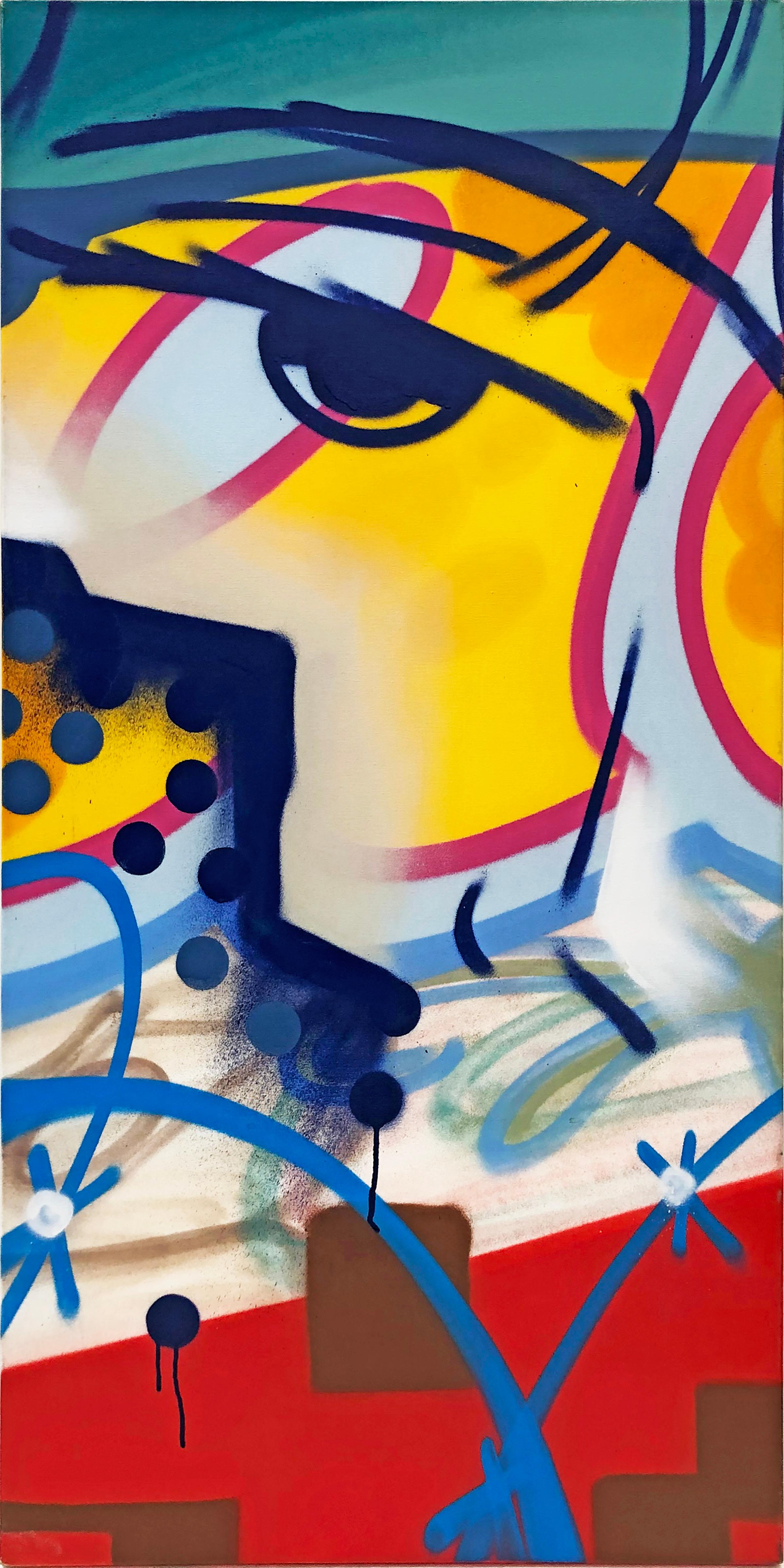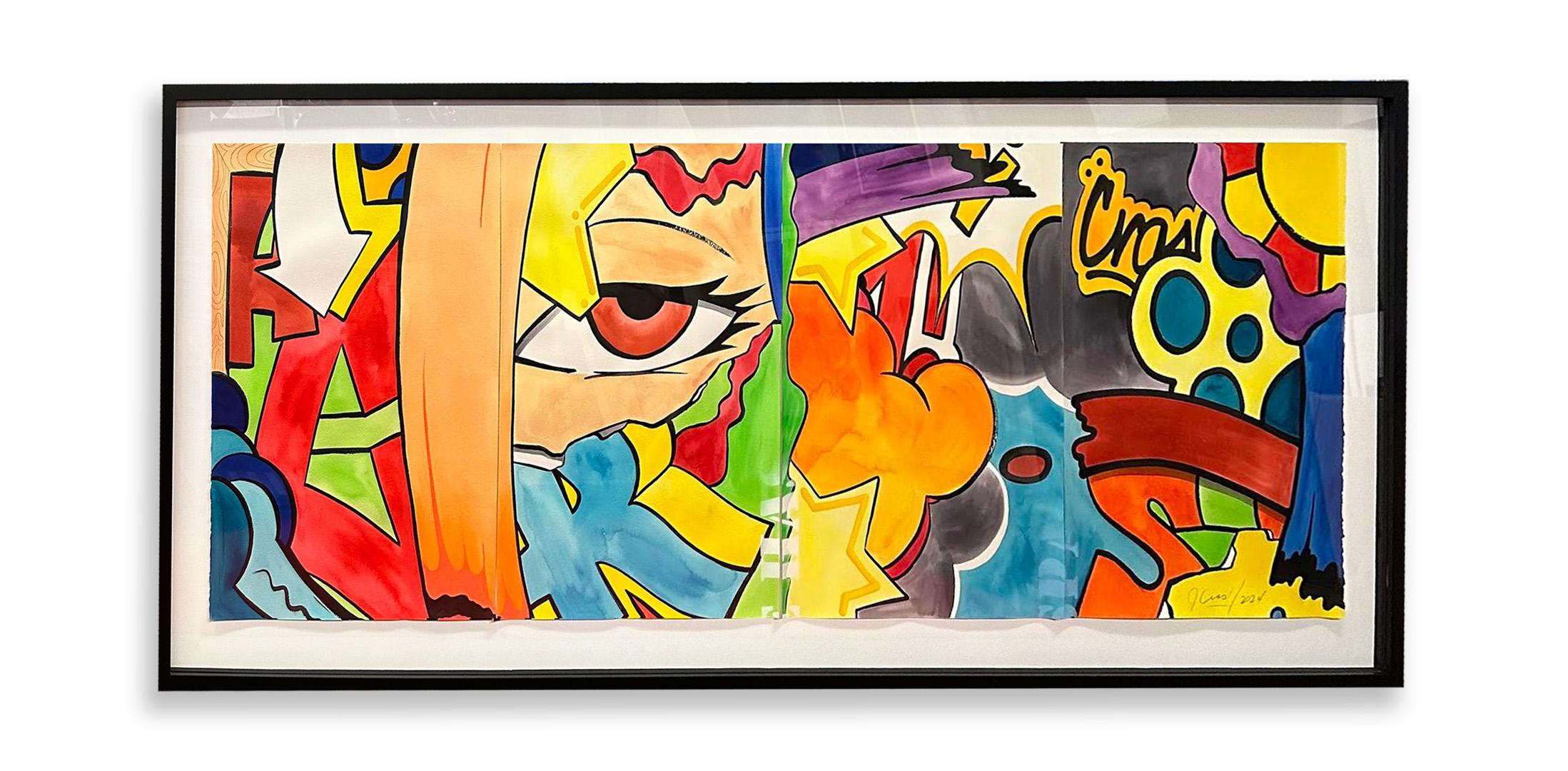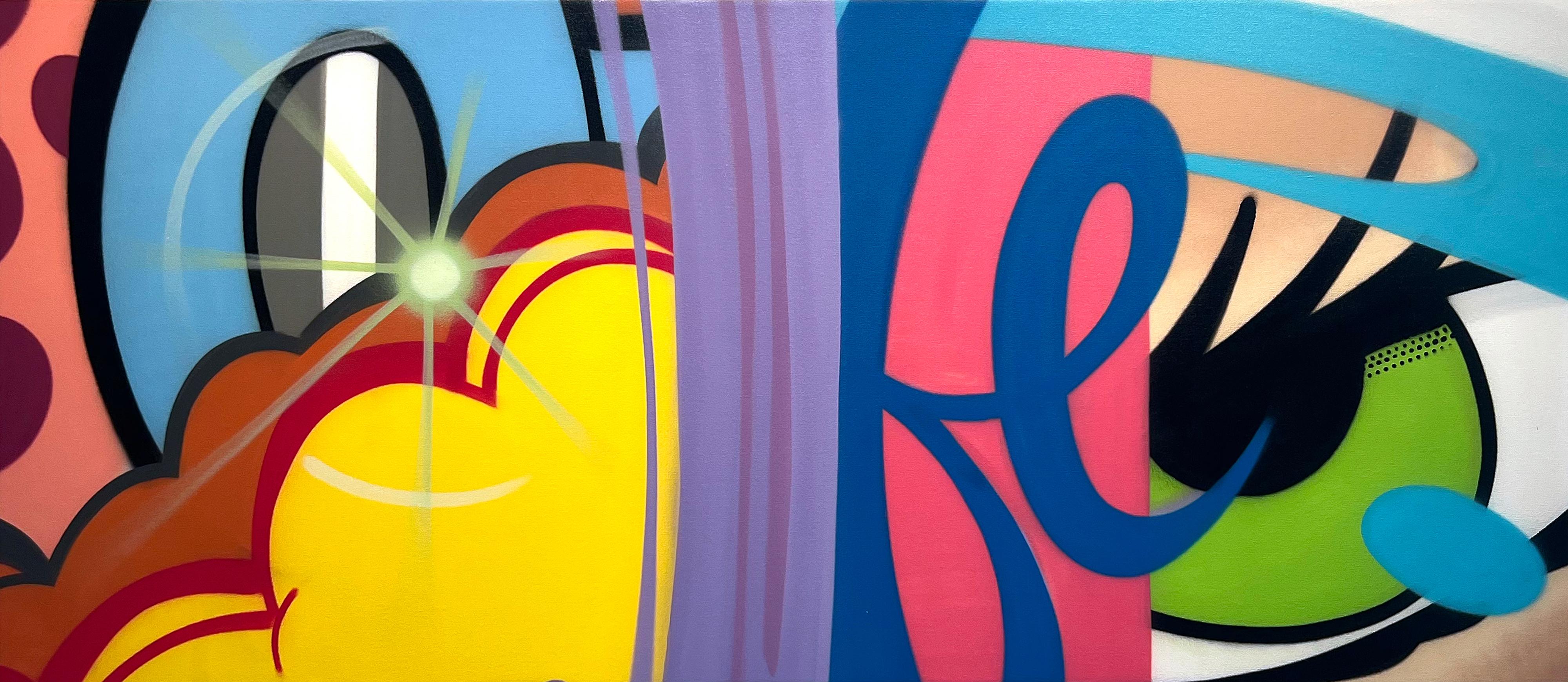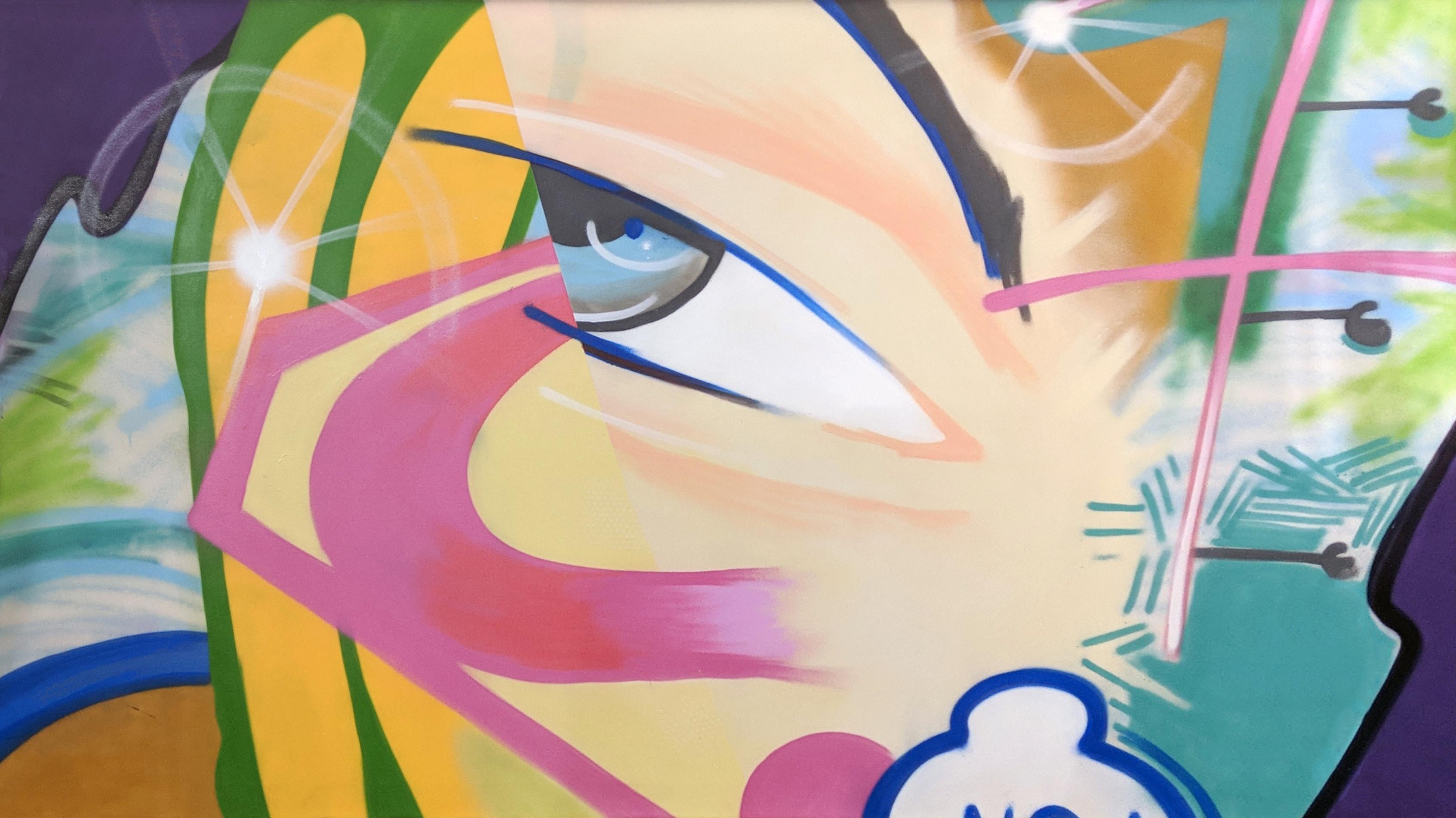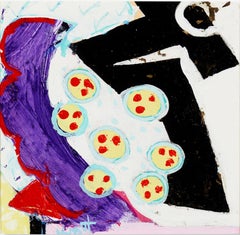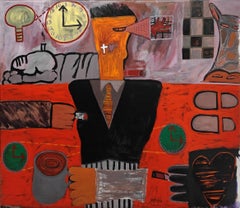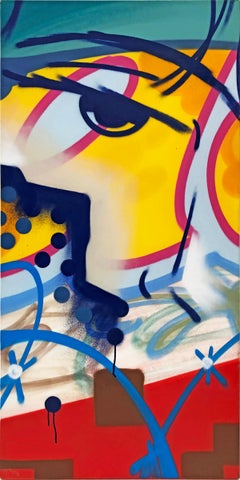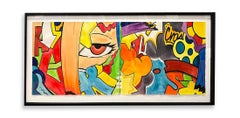Items Similar to "Untitled, " Crash, Pop Art, Street Art Graffiti, Figure with Clock
Want more images or videos?
Request additional images or videos from the seller
1 of 10
John Crash Matos"Untitled, " Crash, Pop Art, Street Art Graffiti, Figure with Clock1989
1989
$4,000
£3,058.34
€3,500.79
CA$5,640.48
A$6,140.30
CHF 3,277.84
MX$74,127.48
NOK 41,214.81
SEK 38,306.45
DKK 26,145.80
About the Item
Crash
Untitled, 1989
Signed and dated lower left
Watercolor and ink on paper
30 x 20 1/2 inches
A contemporary of Keith Haring and a modern-day master of this present day art form of graffiti, Crash (John Matos) shoots his metaphorical arrows into art galleries, subway cars, and dizzying flashes across concrete walls. His work is intended to be a statement in time and space that celebrates the movements and change of an ever changing world. His work is a direct descendant of the Roman wall-scribes, but he strives to evolve this inherited gift back to its simplest form: "tagging," leaving his name. Great artists sign their names on the paintings they leave behind, in this new/old incarnation the artist leaves just his name. A reduction of unadulterated form; or "refined" art.
Even in its newly evolved forms, far from its beginnings on subway cars, the message of graffiti has been "decorate this."
Artist Statement: From colorful faux wall paper, to Marvel Comics, this was my youth. New York in the 60's had a life all its own. And being a child of the 60's, colors made such an impression on me that I rely on these memories to bring me to my work today.
Whether is was an escape from the toughness of my neighborhoods, or an explosive imagination, drawing and painting was a launch pad that would change my life. I believe that if you pour your heart into your work it will show. Well, how about pouring your heart into your work, and letting your imagination take you beyond its limits? Isn't that what being a child was all about?
And, I still believe that if you give in to your imagination, and pour your heart into your work, you can't lose!
- Creator:John Crash Matos (1961, American)
- Creation Year:1989
- Dimensions:Height: 34 in (86.36 cm)Width: 26 in (66.04 cm)
- Medium:
- Movement & Style:
- Period:
- Condition:
- Gallery Location:New York, NY
- Reference Number:1stDibs: LU1841211697092
John Crash Matos
Born John Matos in 1961, CRASH was raised in the Bronx, New York. At the age of 13, he began following the older teens from his neighborhood to the train yards and began bombing. Taking the name “CRASH” after he accidentally crashed the computer in his school, his name began appearing on trains circulating all throughout New York City. By 1980, he began transitioning from train yards to galleries. He curated the groundbreaking "Graffiti Art Success for America" at Fashion MODA, launching the graffiti movement that has remained very active through today. CRASH’s career took off and he saw instant popularity throughout Europe and America, and eventually Asia. CRASH has been part of numerous museum and gallery shows around the world focusing on Graffiti and Street Art, and has works in many permanent museum collections. Visually iconic, he has partnered with many companies for projects including Absolut Vodka, Fender Guitars, SoBella Handbags, Levi’s, and most recently, Tumi luggage and Morphik. He continues to work and show both locally and internationally. Enjoy the awe and power of CRASH!
About the Seller
5.0
Platinum Seller
Premium sellers with a 4.7+ rating and 24-hour response times
Established in 2022
1stDibs seller since 2022
132 sales on 1stDibs
Typical response time: <1 hour
- ShippingRetrieving quote...Shipping from: New York, NY
- Return Policy
More From This Seller
View All"Pleased to See You, " Crash, Pop Art, Street Art Graffiti
By John Crash Matos
Located in New York, NY
Crash
Pleased to See You, 1989
Signed and dated lower left
Watercolor and ink on paper
30 x 20 1/2 inches
A contemporary of Keith Haring and a modern-day master of this present day ...
Category
1980s Street Art Figurative Paintings
Materials
Paper, Ink, Watercolor
"Untitled" Knox Martin, Abstract Expressionism, Purple, Yellow, Black
By Knox Martin
Located in New York, NY
Knox Martin (1923 - 2022)
Untitled
Signed to lower edge
Acrylic and gold foil on canvas
9 x 9 inches
Knox Martin (1923-2022) was an esteemed New York School painter. Knox Martin was born in 1923 in Barranquilla, Colombia. He was the son of the aviator, painter, and poet William Knox Martin, the first man to fly over the Andes Mountains.
After serving in World War II, Knox Martin attended the Art Students League of New York on the G.I. Bill from 1946-1950, where he studied with Harry Sternberg, Vaclav Vytlacil, Will Barnet, and Morris Kantor.
In 1954, Knox Martin's friend Franz Kline placed a painting of his in the Stable Gallery Annual. Charles Egan of the renowned Charles Egan Gallery saw Knox Martin's painting at the Stable Gallery and asked Martin to show his work in a one-man show for the tenth anniversary of the Egan Gallery.
Since then, Knox Martin was a celebrated painter, sculptor and muralist. Knox Martin had an extensive exhibition record and his work is in museum, corporate and private collections worldwide. His two best-known murals in NYC are Venus and Woman with Bicycle...
Category
Late 20th Century Abstract Abstract Paintings
Materials
Gold, Foil
$3,000 Sale Price
20% Off
"Untitled, " Sebastian Gross-Ossa, Contemporary Figurative Painting
Located in New York, NY
Sebastian Gross-Ossa (American, b. 1966)
Untitled, 2000
Oil on canvas
14 1/8 x 11 inches
Signed and dated on the reverse
Category
Early 2000s Contemporary Figurative Paintings
Materials
Oil, Canvas
$3,200 Sale Price
20% Off
"Untitled" Lawrence Philp, Abstracted Surrealist Forms by Afro-American Artist
Located in New York, NY
Lawrence Philp
Untitled
Oil and acrylic on canvas
75 1/2 x 79 inches
Lawrence Philp, the son of Jamaican immigrants, studied at the Rhode Island School of Design and was included i...
Category
1970s Post-Modern Abstract Paintings
Materials
Canvas, Oil, Acrylic
"Untitled" Larry Calcagno, Trompe-l'œil Mixed-Media Minimalist Composition
By Larry Calcagno
Located in New York, NY
Larry Calcagno
Untitled
Mixed media on canvas
36 x 23 1/3 inches
Lawrence Calcagno, better known as Larry, was an artist who gained notoriety during t...
Category
20th Century Modern Figurative Paintings
Materials
Canvas, Mixed Media
$4,800 Sale Price
20% Off
"The Beginning" Aaron Bohrod, Pun Humor, Magic Realism, Alphabet Letters, Text
By Aaron Bohrod
Located in New York, NY
Aaron Bohrod
The Beginning, 1990
Signed center
Oil on gesso board
10 x 8 inches
Aaron Bohrod's work has not been limited to one style or medium. Initially recognized as a regionalis...
Category
1990s Realist Animal Paintings
Materials
Oil, Board
You May Also Like
Untitled (Large Graffiti Painting)
By John Crash Matos
Located in Aventura, FL
Original acrylic and spray paint on canvas. Hand signed, titled and dated on verso by John Crash Matos. Canvas is stretched.
Artwork is in excellent condition. Certificate of Aut...
Category
Early 2000s Street Art Figurative Paintings
Materials
Canvas, Spray Paint, Acrylic
$9,000 Sale Price
40% Off
Simply...Crash! (Huge Graffiti Painting)
By John Crash Matos
Located in Aventura, FL
Original acrylic and spray paint on canvas. Hand signed, titled and dated on verso by John Crash Matos Canvas is stretched.
Artwork is in excellent condition. Certificate of Auth...
Category
2010s Street Art Figurative Paintings
Materials
Canvas, Spray Paint, Acrylic
$24,000 Sale Price
40% Off
Spray Paint/Graffiti/Street Art/Pop_John "CRASH" Matos, Urban Odyssey
By John Crash Matos
Located in Laguna Beach, CA
John CRASH Matos
"Urban Odyssey (4 Panels)"
Watercolor, Spray Paint and Ink on Arches Paper
34.5 x 85.5 inches, Framed
Born John Matos in 1961, CRASH was raised in the Bronx, New Yo...
Category
2010s Street Art Mixed Media
Materials
Watercolor
$9,000 Sale Price
25% Off
Untitled (Large Graffiti Painting)
By John Crash Matos
Located in Aventura, FL
Original acrylic and spray paint on canvas. Hand signed, titled and dated on verso by John Crash Matos. Canvas is stretched.
Artwork is in excellent condition. Certificate of Au...
Category
Early 2000s Street Art Figurative Paintings
Materials
Canvas, Spray Paint, Acrylic
$9,000 Sale Price
48% Off
Spray Paint on Canvas/Graffiti/Street Art_Melancholy Drama_John "CRASH" Matos
By John Crash Matos
Located in Laguna Beach, CA
John CRASH Matos
"Melancholy Drama"
Spray Paint on Canvas
30.25 x 69.25 inches
Born John Matos in 1961, CRASH was raised in the Bronx, New York. At the age of 13, he began followin...
Category
2010s Street Art Abstract Paintings
Materials
Canvas, Spray Paint
$13,500 Sale Price
25% Off
Super, Just Super (Huge Graffiti Painting)
By John Crash Matos
Located in Aventura, FL
Original acrylic and spray paint on canvas. Hand signed, titled and dated on verso by John Crash Matos. Canvas is stretched.
Artwork is in excellent condition. Certificate of Authen...
Category
Early 2000s Street Art Mixed Media
Materials
Enamel
$18,000 Sale Price
40% Off
More Ways To Browse
Subway Car
Subway Graffiti
African Faces
Surreal Figure
Classical Figurative Paintings
The Kiss Painting
David Manning
French Impressionist Sketch
La Madeleine
Russian Palace
Vintage Ballerina Painting
Antique Painting Of Children
Egg Tempera Contemporary Painting
Oil Painting Xix
Very Large Oil Paintings
Young Girl Young Boy Painting
France 1870 Art
Old Dutch Paintings
